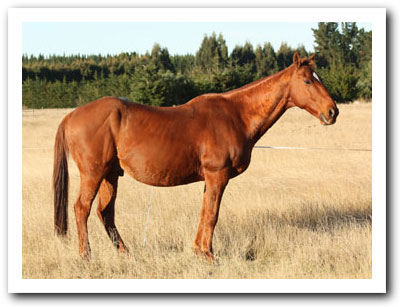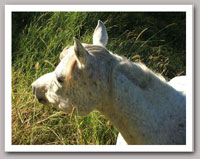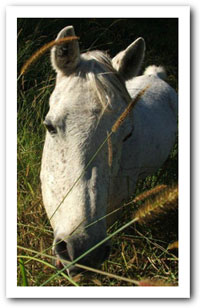Signs of Calcium Deficiency
- Ill-thrift, loss of top-line and poor hoof quality
- Unevenness of movement or ‘shifting lameness’
- Hard, bony lumps and splints. Propensity for ‘shin soreness’
- Increased susceptibility to fractures under stress
- X-Rays show demineralisation of bone mass including the pedal bone in the hoof
- Poor tooth quality, loose teeth, difficulty chewing
- Onset of a ‘Dippy’ or Sway-back, osteoporosis, arthritis
- Premature end to useful life
- ‘Big-Head’ where calcium withdrawal from the skeleton has progressed to the point the bone matrix has been replaced with softer connective tissue, starting with the bones of the skull. Swelling of the jaws and nasal bones grossly deform the head.
NB It is significant that many of these symptoms are identical to those associated with a lack of sodium. It is likely the low levels of sodium also found in these oxalate grasses contribute significantly to the calcium deficiency.
Persil (right) is displaying the classic signs of a calcium deficiency.
Pregnant mares and growing horses
The consequences of consuming oxalate pastures on the adult horse is bad enough but think about the implications for the pregnant mare and the foal as it grows up. It is a ‘no-brainer’ to take steps to avoid calcium deficiency in the growing horse to ensure they are strong, robust and reach their full height without debilitating ‘Developmental Orthopedic Diseases’ (DOD, or malformations of cartilage, joints and skeleton).
Prevention
Prevention is far easier and cheaper than ‘Cure’. It can take up to 12 months of correct supplementation to re-mineralise bones, during which time the horse should not be ridden, to avoid possible fractures.
The primary principal of prevention is not just to supplement heaps of calcium as calcium is useless on its own.
Equally important are the ‘co-factors’ or other nutrients essential for calcium to be absorbed across the intestinal wall into the bloodstream from where it is available to carry out its many functions, one of which is to become part of bone structure.
The primary principal of prevention is to ensure calcium does not leave the bones!
This requires the presence of not only calcium but also the various co-factors which include: magnesium, boron, phosphorous, sodium, Vitamin D and an acidic environment.
Chelated calcium is already bound to an amino acid and therefore cannot be ‘stolen’ by oxalates. An excellent supplement will contain chelated calcium plus the co-factors mentioned above. Feeding the right sort of Calcium alongside your multi vit & min (which contains all the necessary trace minerals and essential vitamins) will keep your horse strong and healthy, greatly extending his useful life.
Calcium Carbonate?

Horse suffering from 'Big Head'.
What’s wrong with Calcium Carbonate or DCP?
- As it is inorganic you have to feed large quantities (up to 200gms/day for a 500kg horse) and the more you feed the less absorption is achieved
- Calcium carbonate tends to alkali the gut environment which is counterproductive to absorption
- The essential co-factors are missing especially Vit D without which calcium does not make it from the intestine into the bloodstream; and magnesium without which calcium cannot be deposited in the bones; and boron without which various quantities of calcium and magnesium are lost via the urine.

What about Lucerne (Alfalfa)?
Sure lucerne is high in Calcium but it is also low in phosphorous. It is also very high in potassium and very low in sodium.
It is another unbalanced feed which has to be compensated for. If your horse already has an imbalance from the grass, feeding lucerne just adds more complications.
Best to feed plain grass hay (Rhodes is ideal) with appropriate supplements (Supreme Vit & Min, Xtra Cal and Graze Ezy)

Read: “The Least Known, Most Important Thing You Need to Know About Lucerne”
 Calm Healthy Horses
Calm Healthy Horses